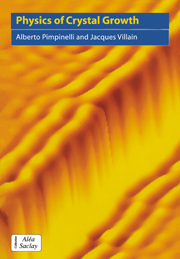Book contents
- Frontmatter
- Contents
- Preface
- List of symbols
- 1 Morphology of a crystal surface
- 2 Surface free energy, step free energy, and chemical potential
- 3 The equilibrium crystal shape
- 4 Growth and dissolution crystal shapes: Frank's model
- 5 Crystal growth: the abc
- 6 Growth and evaporation of a stepped surface
- 7 Diffusion
- 8 Thermal smoothing of a surface
- 9 Silicon and other semiconducting materials
- 10 Growth instabilities of a planar front
- 11 Nucleation and the adatom diffusion length
- 12 Growth roughness at long lengthscales in the linear approximation
- 13 The Kardar-Parisi-Zhang equation
- 14 Growth without evaporation
- 15 Elastic interactions between defects on a crystal surface
- 16 General equations of an elastic solid
- 17 Technology, crystal growth and surface science
- Appendix A From the discrete Gaussian model to the two-dimensional Coulomb gas
- Appendix B The renormalization group applied to the two-dimensional Coulomb gas
- Appendix C Entropic interaction between steps or other linear defects
- Appendix D Wulff's theorem finally proved
- Appendix E Proof of Frank's theorem
- Appendix F Step flow with a Schwoebel effect
- Appendix G Dispersion relations for the fluctuations of a train of steps
- Appendix H Adatom diffusion length ℓs and nucleation
- Appendix I The Edwards-Wilkinson model
- Appendix J Calculation of the coefficients of (13.1) for a stepped surface
- Appendix K Molecular beam epitaxy, the KPZ model, the Edwards-Wilkinson model, and similar models
- Appendix L Renormalization of the KPZ model
- Appendix M Elasticity in a discrete lattice
- Appendix N Linear response of a semi-infinite elastic, homogeneous medium
- Appendix O Elastic dipoles in the z direction
- Appendix P Elastic constants of a cubic crystal
- References
- Index
11 - Nucleation and the adatom diffusion length
Published online by Cambridge University Press: 07 May 2010
- Frontmatter
- Contents
- Preface
- List of symbols
- 1 Morphology of a crystal surface
- 2 Surface free energy, step free energy, and chemical potential
- 3 The equilibrium crystal shape
- 4 Growth and dissolution crystal shapes: Frank's model
- 5 Crystal growth: the abc
- 6 Growth and evaporation of a stepped surface
- 7 Diffusion
- 8 Thermal smoothing of a surface
- 9 Silicon and other semiconducting materials
- 10 Growth instabilities of a planar front
- 11 Nucleation and the adatom diffusion length
- 12 Growth roughness at long lengthscales in the linear approximation
- 13 The Kardar-Parisi-Zhang equation
- 14 Growth without evaporation
- 15 Elastic interactions between defects on a crystal surface
- 16 General equations of an elastic solid
- 17 Technology, crystal growth and surface science
- Appendix A From the discrete Gaussian model to the two-dimensional Coulomb gas
- Appendix B The renormalization group applied to the two-dimensional Coulomb gas
- Appendix C Entropic interaction between steps or other linear defects
- Appendix D Wulff's theorem finally proved
- Appendix E Proof of Frank's theorem
- Appendix F Step flow with a Schwoebel effect
- Appendix G Dispersion relations for the fluctuations of a train of steps
- Appendix H Adatom diffusion length ℓs and nucleation
- Appendix I The Edwards-Wilkinson model
- Appendix J Calculation of the coefficients of (13.1) for a stepped surface
- Appendix K Molecular beam epitaxy, the KPZ model, the Edwards-Wilkinson model, and similar models
- Appendix L Renormalization of the KPZ model
- Appendix M Elasticity in a discrete lattice
- Appendix N Linear response of a semi-infinite elastic, homogeneous medium
- Appendix O Elastic dipoles in the z direction
- Appendix P Elastic constants of a cubic crystal
- References
- Index
Summary
The theoretical villain, however, was what
Dr. Breed called ‘a seed’. The seed,
which had come from God-only-knows-where,
taught the atoms the novel way in which
to stack and lock, to crystallize, to freeze.
K. Vonnegut (Cat's cradle)During molecular beam epitaxy, atoms arrive on the surface, and diffuse over a length ℓs before being incorporated into the crystal. Can we estimate ℓs The solution to this problem is contained in review articles by Stoyanov & Kashchiev (1981) and by Venables et al. (1984).
The simplest case is realized when two diffusing adatoms form an immobile and undissociable pair when they meet, and the resulting cluster grows with a compact shape. Stoyanov & Kashchiev have shown that in this case ℓs ∼ (D/F)1/6, where D is the diffusion constant of adatoms and F the deposition flux. More generally, they have shown that ℓs ∼ (D/F)γ, where γ is a function of the critical nucleus size. The critical nucleus is defined as the largest dissociable atom cluster. The experimental verification is not that easy: the critical nucleus size, and thus γ, depend in an unspecified way on the temperature and the deposition flux. A large host of computer simulation data (Monte Carlo) have anyway confirmed the relation between ℓs, D and F.
Orders of magnitude – The lengths should be less than the distances between defects on the surface, i.e. a few microns at the very best. The temperature must be low–which means below 0 °C for metals–otherwise ℓs becomes too long.
Experimental techniques– Microscopy (STM, LEEM, REM), atom-beam scattering, high-energy electron diffraction.
- Type
- Chapter
- Information
- Physics of Crystal Growth , pp. 181 - 200Publisher: Cambridge University PressPrint publication year: 1998
- 1
- Cited by



